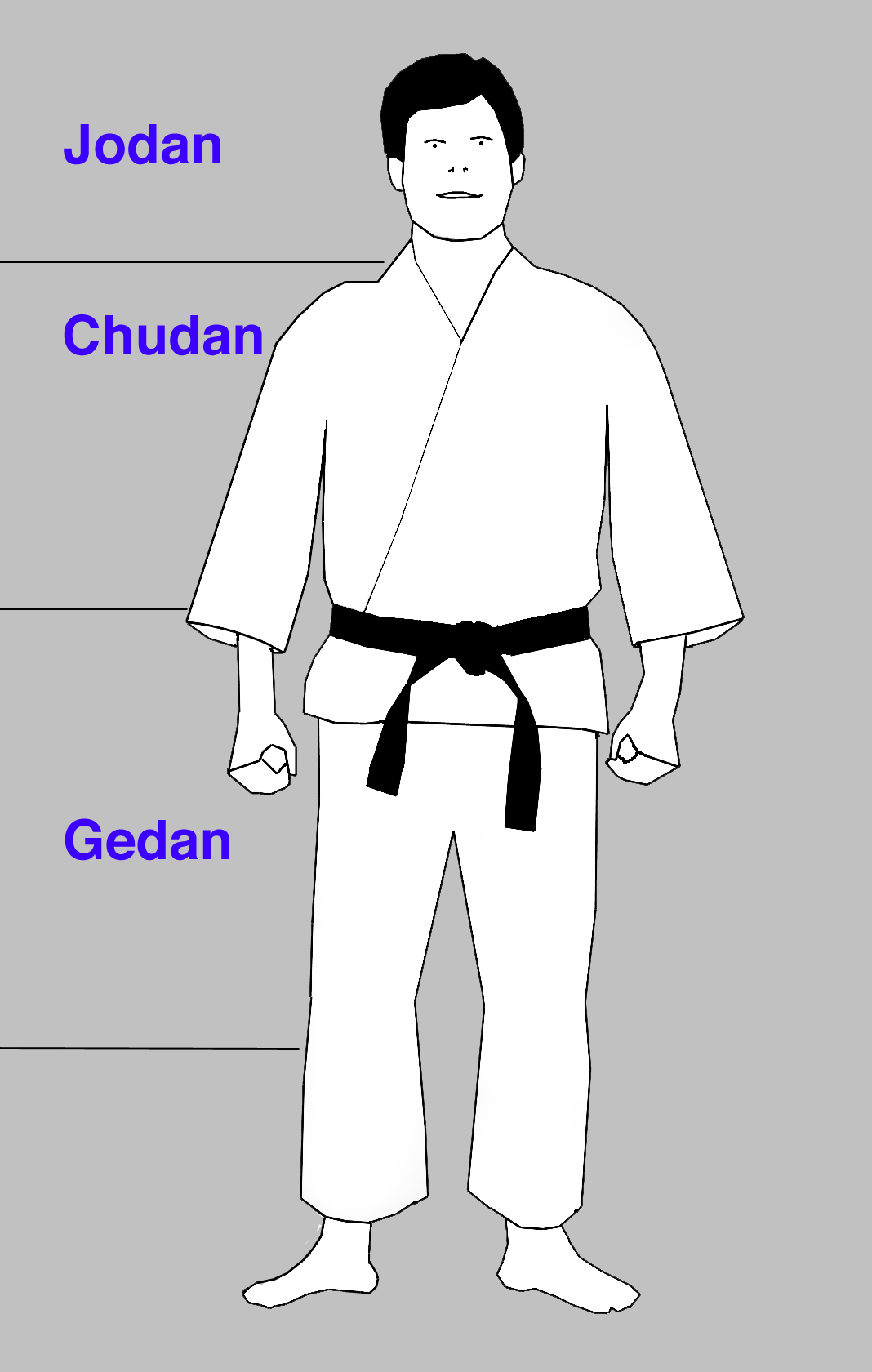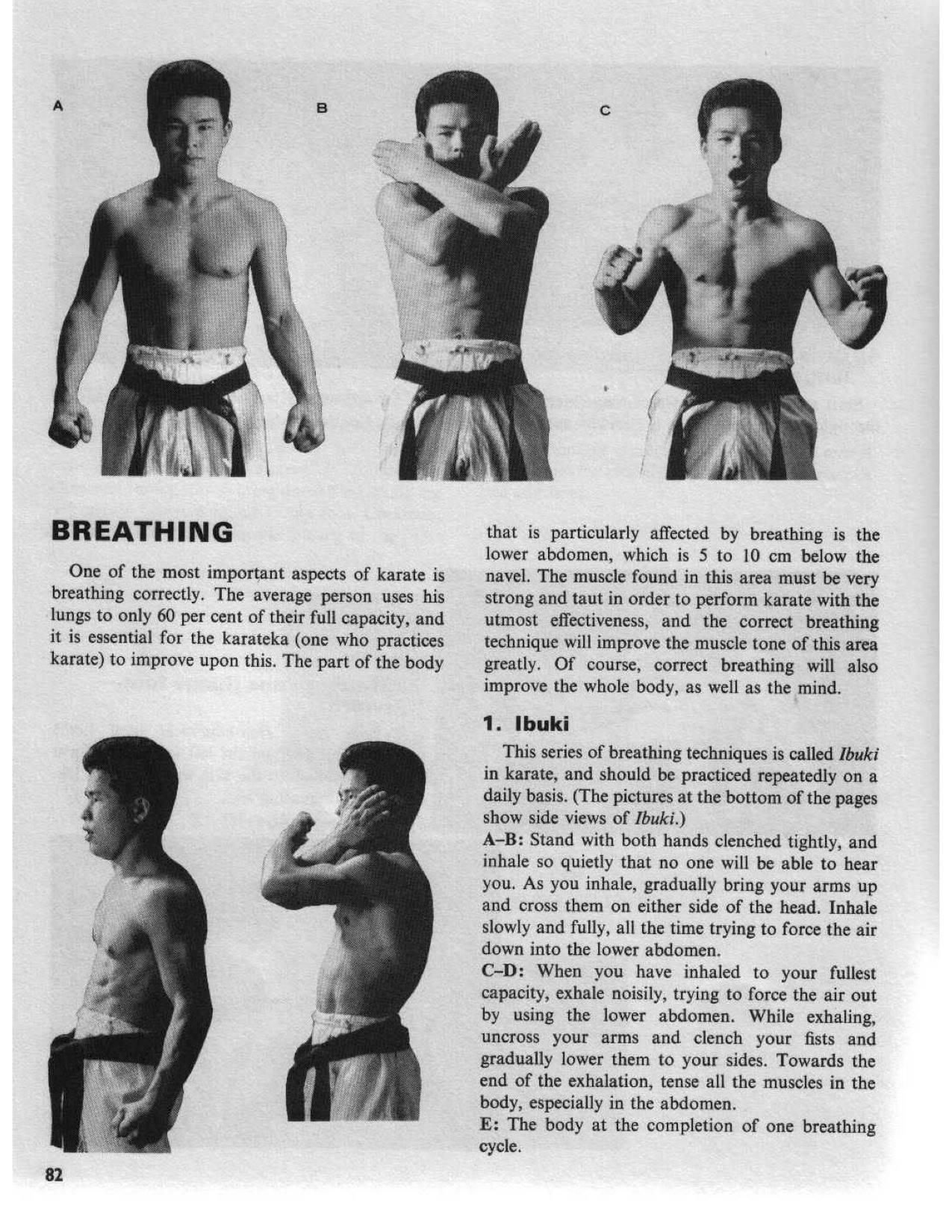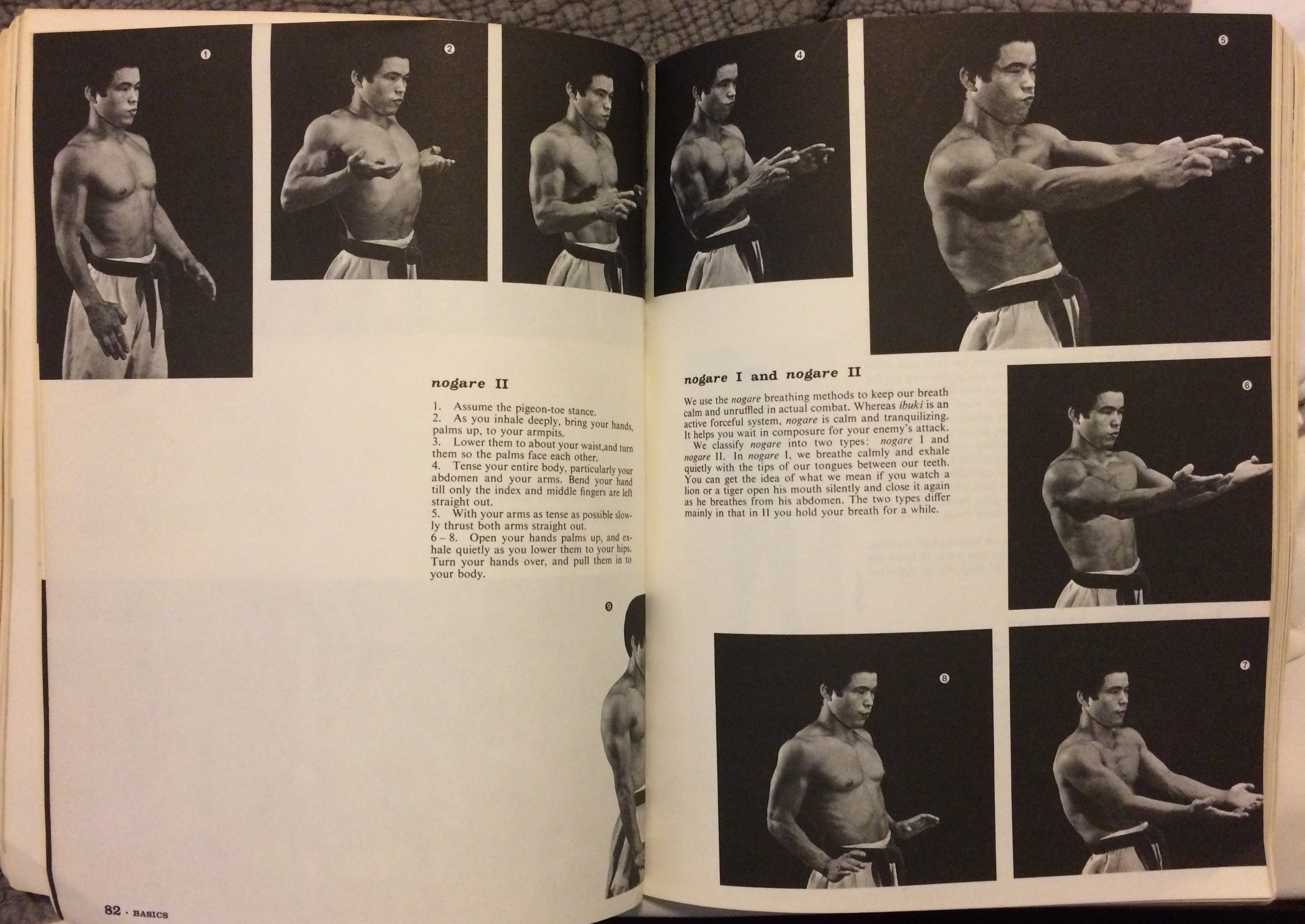Karate
Fleeting- Référence externe : https://toriwaerts.wordpress.com/2012/05/02/ibuki-breathing/
mon attitude vis à vis des ceintures de karate
Depuis que j’ai atteint la ceinture marron de karaté, tout autour de moi, on suppose que mon objectif est d’atteindre la ceinture noire.
Mon objectif final est de faire de mon mieux pour m’améliorer tout le temps. Pour moi, les ceintures ne sont pas des objectifs à atteindre, mais des mesures de mon niveau suivant les différents critères d’importance.
Avec le premier dan, j’ai l’impression d’observer une inversion mesure-objectif. Souvent, les arguments que j’entends sont « au passage de ceinture, on va te demander ceci ou cela ». À mon avis, ces arguments ne sont pas valables. Je préfère étudier une technique pour ce qu’elle m’apporte plutôt que pour passer un grade.
Pour appliquer l’idée de “feel confident not doing what you are not doing”, j’oriente toutefois mes leçons sur le programme de la ceinture noire. Car tant que je n’ai pas ce niveau, ils m’apprennent quelque chose dans la discipline, donc autant en faire une area of focus.
Si la ceinture noire était mon objectif, je ne chercherais à connaître QUE deux katas, à calculer pour viser la moyenne en délaissant les exercices difficiles pour moi et enfin j’exacerberais les points qui sont sensée impressionner un jury (pousser des kiais forts mais sans énergie).
En conclusion, je passe volontiers les examens de passage de grade, car je pense que la ceinture est une mesure intéressante de mon niveau, mais travailler des sujets dont le SEUL but annoncé est de satisfaire un jury me semble incompatible avec mes valeurs.
fédérations
ffkda
règlement
2022
- Référence externe : https://www.ffkarate.fr/wp-content/uploads/2021/12/2021-2022-CSDGE-TECHNIQUE-KARATEv2.pdf ()
2024
- Référence externe : https://www.ffkarate.fr/wp-content/uploads/2024/03/CSDGE-TECHNIQUE-PARTIE-KARATE-2023-2024_V2.pdf ()
CSDGE-TECHNIQUE-PARTIE-KARATE-2023-2024_V2-2-kata-list.pdf
CSDGE-TECHNIQUE-PARTIE-KARATE-2023-2024_V2-2-kata.pdf
CSDGE-TECHNIQUE-PARTIE-KARATE-2023-2024_V2-2-kihon.pdf
CSDGE-TECHNIQUE-PARTIE-KARATE-2023-2024_V2-2-kumite.pdf
CSDGE-TECHNIQUE-PARTIE-KARATE-2023-2024_V2-2-techniques.pdf
wukf
règlement
2024
- Référence externe : https://wukffrance.com/wp-content/uploads/2020/10/reglement-grades-karate-wukf-france-1.pdf ()
rôles
uke
tori
kata
bassai dai
Intéressante façon de faire les gedan sukui uke ici ->
heian
nidan
shodan
https://youtu.be/Xdx1igUvmlU (slow)
bunkai
Heian Shodan Bunkai Movements 4-6
- Référence externe : from Applied Shotokan by Andy Allen
nidan
bunkai
By Jesse Enkamp, gives a nice explanation of the flow of shuto uke
yodan
heian yodan
https://karate-blog.net/heian-yodan-le-kata-aux-5-coups-de-pied/
bunkai
bunkai yodan
Par Dider Lupo
- Sur la première séquence, sur le yoko geri,
- https://youtu.be/vgxMHbIuHSA?t=573 pour le uraken + yoko geri
- https://youtu.be/LPku1P9-Rkk?t=50 interprétation du Juji Uke en gedan barai testui, puis utilisation du morote uke pour frapper (uchi)
- https://youtu.be/LPku1P9-Rkk?t=207 morote de fin devient uchi uke ura zuki, puis coup de genou et shuto uke devient une projection
https://www.techniquesdekarate.com/les-kata-du-shotokan/heian-yondan
godan
bunkai
Par Dider Lupo
- Sur le [juji uke](#d4123d9c-c2e6-4e32-9e47-c826d4594055) et le [manji uke](#3f055efd-4d0a-4473-b56a-3c94df9cd7e6)
- Sur la première séquence, le juji uke, le saut, le [manji uke](#3f055efd-4d0a-4473-b56a-3c94df9cd7e6),
Par Lionel Froidure
- Sur la première séquence
Par Eric Delanoy
- Une utilisation intéressante de la séquence de [morote uke](#df28229c-38fd-4c1f-a17e-075a97d549c4)
bunkai
In One Bunkai For Every Pinan / Heian Kata, Jesse Enkamp gives a nice explanation to start with the position with both wrists grabbed.
Also, he gives good rationalizations in here
kata checklist
kata checklist
- rythm
- embusen
- stances
- waza
- direction
- hands
Juji Uke
- Référence externe : https://www.karatedo.asia/bunkai/juji-uke/
manji uke
manji uke
attaques et défenses: temps
https://nicolaslorber.com/2017/06/01/sen-no-sen-go-no-sen-et-autres-timings-de-combat/
Sen No Sen - Anticipation de l’attaque
-
Référence externe : http://technique-karate.com/sen-no-sen.htm Sen No Sen - Anticipation de l’attaque
différence du Go No Sen, dans le Sen No Sen, l’attaque doit être anticipée pour que la contre-attaque se fasse dans le même temps que l’attaque
L’attaque se fait dans l’attaque
Sen Sen No Sen - Attaque preventive
-
Référence externe : http://technique-karate.com/sen-sen-no-sen.htm Sen Sen No Sen - Attaque preventive
Sen Sen No Sen est l’étape ultime qui suit le Sen No Sen puisque la contre attaque se fait avant même l’attaque de l’adversaire
attaque préventive, face au comportement agressif de l’adversaire.
Sen Sen No Sen d’être dans un tel état de vigilance, à sa position, ses déplacements que vous pouvez décrypter son intention et agir par prévention pour éviter de vous retrouver en réaction avec le danger inhérent de subir son attaque.
pré-empter l’attaque de votre adversaire.
Iro No Sen
-
Référence externe : http://technique-karate.com/iro-no-sen.htm Iro No Sen
l’anticipation de l’attaque par un blocage réalisé en rentrant dans l’attaque
l’initiative avant l’initiative pour prendre de vitesse l’adversaire et ne pas le laisser déployer sa technique avec efficacité
Tai No Sen - Esquive
-
Référence externe : http://technique-karate.com/tai-no-sen.htm voir tai sabaki
Tai (attendre) No Sen (premier pas) est une réaction par rapport à l’initiative adverse, par une esquive (non pas un blocage comme en Go No Sen) puis une contre-attaque
Sen - Avant
-
Référence externe : http://technique-karate.com/sen.htm Sen - Avant
référence aux différentes manières de reprendre l’initiative face à une attaque, de manière réactive, simultanée ou anticipée. L
Sen signifie “avant”, Go signifie “Après”
Go no sen - Après l’attaque • Sen no sen - Attaque dans l’attaque • Sen sen no sen - Attaque avant l’attaque
Go No Sen - Reaction
-
Référence externe : http://technique-karate.com/go-no-sen.htm
-
Référence externe : https://en.wikipedia.org/wiki/Go_no_sen
not just counter-attack. Go no sen is a mental state, a level of concentration assumed during combat. It is more correct to say that it is a harmonization with the very movement of attack, not just defense.[
go no sen can be seen as part of a philosophical and moral code, emphasized when one considers the term “dō” (道), meaning that the budōka (武道家, follower of budō) should never take the initiative in an eventual and inevitable confrontation.
En Go (après) No Sen (premier pas), le défenseur est en réaction suite à l’attaque. Il bloque, puis il contre après avoir contrôlé l’attaque. C’est le contrôle de l’attaque qui permet d’ouvrir les opportunités de contre-attaque
pas simplement une défense et contre-attaque. Le Go No Sen implique un état mental spécifique pour que la reprise de l’initiative se réalise en harmonie avec le mouvement de l’attaque, même si elle se réalise après l’attaque sur la ligne temporelle.
names
Ge - Inferieur
-
Référence externe : http://technique-karate.com/ge.htm Ge - Inferieur
Inférieur
gedan
-
Référence externe : http://technique-karate.com/gedan.htm Gedan - Niveau Bas
Niveau inférieur du corps, sous la ceinture. Voir aussi Chudan et Jodan.

Ma Ai
-
Référence externe : http://www.technique-karate.com/ma-ai.htm
Ma significie distance ou intervalle et Ai signifie l’Harmonie
perception immédiate et permanente du Ma Ai qui permet de déclencher le choix de la technique et son timing.
timing qui “unit” les partenaires dans le combat
Zanshin - Finalisation parfaite de l’action
-
Référence externe : http://www.technique-karate.com/zanshin.htm
attentif à ce qui se passe, ici et maintenant
kime - Energie concentrée
-
Référence externe : http://www.technique-karate.com/kime.htm
concentrer tout son Ki à l’impact de la technique
Ude - Avant bras
- Référence externe : http://www.technique-karate.com/ude.htm
Hanmi - Position des hanches à 45
-
Référence externe : http://www.technique-karate.com/hanmi.htm
Position des hanches à 45, vers l’extérieur.
tecnics
parties du corps au karaté
-
Référence externe : https://fr.wikipedia.org/wiki/Parties_du_corps_au_karat%C3%A9
Les différentes parties du pied sont :
- Haisoku : dessus du pied
- Koshi : bol du pied (partie avant de la plante, sous les orteils)
- Tsumasaki : pointe du pied
- Sokuto : sabre du pied (tranchant extérieur)
- Teisoku : plante du pied (arche intérieure)
- Kakato : talon
— https://fr.wikipedia.org/wiki/Parties_du_corps_au_karat%C3%A9

— https://fr.wikipedia.org/wiki/Parties_du_corps_au_karat%C3%A9
Chusoku - Bol du pied
- Référence externe : http://technique-karate.com/chusoku.htm
Heisoku - Cou du pied
- Référence externe : http://technique-karate.com/heisoku.htm
ippon
-
Référence externe : http://technique-karate.com/ippon.htm
Point
gedan barai
breathing
“ibuki” or quick energy breath
— https://toriwaerts.wordpress.com/2012/05/02/ibuki-breathing/
Ibuki breathing is done at the execution of blocks, kicks, and punches
— https://toriwaerts.wordpress.com/2012/05/02/ibuki-breathing/
is “nogare”, or slow breathing. Nogare breathing is usually done when moving from one position to the next or when there is a pause in the kata
— https://toriwaerts.wordpress.com/2012/05/02/ibuki-breathing/
ibuki and nogare
- Référence externe : http://the-martial-way.com/what-is-ibuki-and-nogare/
goal is to consciously control breathing to unite the mind and body, activate the internal organs and to reach a state of total awareness.
collapsing your diaphragm (and thus your lungs) down instead of inflating them outwards
breath out by slowly contracting (with or without tension) the abdominal wall
which will then push the diaphragm and lungs back up, compressing them and pushing the air out again.
use Ibuki when blocking a strike or delivering a strike, exhale with force and kiai – or shout
Nogare (In – Ibuki) or “Slow/Soft Breathing”
starts from deep within the abdomen
Nogare Breathing:
Stand straight up with the feet shoulder width apart, and with the arms hanging relaxed at the sides. Take a deep breath in through the nose and raise the arms up to chest level keeping the hands open. Bring the hands alongside the chest and force air into the abdomen. Set the breath in the lower abdomen for a moment. With the tongue relaxed behind the upper teeth, exhale slowly. Maintain the tongue behind the upper teeth to help to quiet the breathing. This is repeated several times until one’s breath is calm and one’s heartbeat is pacified.
Nogare is also known as “combat breathing“. Nogare should be used during free fighting.
experience the benefits of simple Ibuki first hand, try breathing in slowly and out sharply as you strike a pad. It is easy to see the benefits of sharp outward breaths when striking. Or the controlled breathing of Nogare to slow your heart rate.
moves
tai sabaki
- Référence externe : https://en.wikipedia.org/wiki/Tai_sabaki
- Référence externe : http://technique-karate.com/tai-sabaki.htm
manoeuvrer le corps afin d’éviter une frappe tout en se positionnant dans une position pour exécuter une contre-attaque
traduit par “évasion” met l’accent sur le Ashi Sabaki (jeu de jambes) et Te Sabaki (travail des mains)
‘whole body movement’, or repositioning
usually used to avoid an attack, such that the receiver of the attack ends up in an advantageous position and it is often wrongly referred to as evasion
example of tai sabaki is ‘moving off the line’ of attack using irimi and tenkan movements rather than to ‘move against’ the attack.
implies the use of harmony rather than physical strength.
Tai sabaki is related to ashi sabaki (footwork) and te sabaki (handwork)
ayumi ashi
- Référence externe :
gedan shuto barai
levels
jodan
chudan
gedan
positions
hachiji dachi
-
Référence externe : https://en.wikipedia.org/wiki/Hachiji_dachi Hachiji dachi - Wikipedia
this refers to the shape of the kanji for the number eight: 八,[2]
While in hachiji dachi, the karateka is usually in a yoi (ready) position.
kiba dachi
kogutsu dachi
zenkutsu dachi
fist
oï zuki
morote uke
gyaku zuki
Kisami-zuki (Jab punch)
- Référence externe : https://www.themartialway.com.au/kisami-zuki-jab-punch/
maete zuki - coup du bras avant
vs kizami zuki ->
tetsui uchi, le marteau de fer
- Référence externe : https://karate-blog.net/tetsui-uchi-le-marteau-de-fer/
choku zuki, le coup de poing fondamental
- Référence externe : https://karate-blog.net/votre-1ere-technique-de-poing-choku-zuki/
shuto uke
nukite
ura zuki
- Référence externe :
foot
kekomi
défonçant
keage
remontant
mawashi geri
mae geri
kin geri (groin kick)
-
Référence externe : https://blackbeltwiki.com/kin-geri Karate Kick - Kin Geri (Groin Kick) - Black Belt Wiki
Kin Geri is a standard self-defense kick. Kin Geri is used as a fast kick to the groin area but it can also target the inner thighs.
ushiro mawashi geri
yoko geri
Explication de la distinction keage vs kekomi ici ->
Notes pointant ici
- 5 Commonly Mispronounced Japanese Words For Karate
- Applied Shotokan by Andy Allen
- Bernard Bilicki
- bunkai
- ceinture noire de karaté
- deuxième dan de karaté
- Dider Lupo
- Eric Delanoy
- Jesse Enkamp
- jiyu ippon kumite
- jiyu ippon kumite
- ju kumite (randori/midare)
- kihon ippon kumite
- kihon ippon kumite
- Lionel Froidure
- One Bunkai For Every Pinan / Heian Kata
- practicing a method: formal description or mystical thoughts
- premier dan de karate
- respiration en karate
- selon la ffkda
- selon la ffkda
- selon la wukf
- techniques
- techniques

